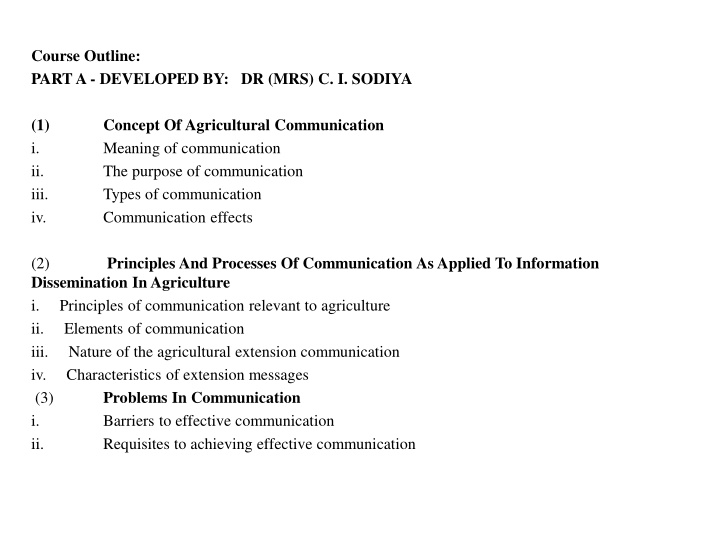
Agricultural Communication Course Outline
Explore the comprehensive course outline on agricultural communication covering concepts, principles, processes, dissemination, theories, models, development communication, media use, audience analysis, news writing, and audio-visual techniques. Gain knowledge and skills to excel in this field.
Download Presentation

Please find below an Image/Link to download the presentation.
The content on the website is provided AS IS for your information and personal use only. It may not be sold, licensed, or shared on other websites without obtaining consent from the author. If you encounter any issues during the download, it is possible that the publisher has removed the file from their server.
You are allowed to download the files provided on this website for personal or commercial use, subject to the condition that they are used lawfully. All files are the property of their respective owners.
The content on the website is provided AS IS for your information and personal use only. It may not be sold, licensed, or shared on other websites without obtaining consent from the author.
E N D
Presentation Transcript
Course Outline: PART A - DEVELOPED BY: DR (MRS) C. I. SODIYA (1) i. ii. iii. iv. Concept Of Agricultural Communication Meaning of communication The purpose of communication Types of communication Communication effects Principles And Processes Of Communication As Applied To Information (2) Dissemination In Agriculture i. Principles of communication relevant to agriculture ii. Elements of communication iii. Nature of the agricultural extension communication iv. Characteristics of extension messages (3) Problems In Communication i. Barriers to effective communication ii. Requisites to achieving effective communication
PART B - DEVELOPED BY: DR. J. M. AWOTUNDE (4) i. ii. iii. iv. THEORIES AND MODELS OF AGRICULTURAL COMMUNICATION Definition of theory and model of communication Differences between theory and model of communication Uses of theories and models in communication Examples of theories and models of communication a. Individual difference theory b. Social category theory c. Social relations theory d. The Lasswell formula (model) e. Shannon and Weaver s model f. Osgood and Shramms Circular model g. Genoner s general model h. Stimulus Response model i. Transactional model j. Rogers and Shoemaker s model k. White Gatekeeper model
PART C - DEVELOPED BY: DR. O. A. Lawal - Adebowale (5) i. ii. iii. iv. DEVELOPMENT COMMUNICATION Meaning of development Communication in development Development support communication Importance of communication in agricultural/ rural development (6) (i). (ii). (iii). (iv). (v). (vi). (vii). (7) ( i) Observation (iii) Surveys MEDIA USE Characteristics of selected media Mass media communication The radio Print materials Audio visual aids Traditional/Folk Media (Oramedia) Campaigns AUDIENCE ANALYSIS (ii) Discussion (iv) Rapid Rural Appraisal
(8) i. ii. iii. iv. v. AGRICULTURAL NEWS WRITING Agricultural news writing Script writing in agriculture Guidelines for script writing Categories of programmes in which agricultural scripts are relevant Editing PART D - DEVELOPED BY: DR. T. O. A. Banmeke (8) AUDIO VISUAL HARD AND SOFTWARES (i) Operation, Care and Maintenance of selected Audio and Visual Equipment (ii) Recording (iii) Modern information and communication Appliances DEVELOPMENT OF KNOWLEDGE AND SKILLS IN THE USE OF Course Requirements: Students are expected to participate in all the course activities and have a minimum of 70% attendance to qualify for writing the final examination. Students will be required to submit a term paper on any of the topics treated in this course. This will account for part of the continuous assessment. Students will be expected to write a short class test and submit assignments. All class assignments should be word processed on A4 paper
Method of Grading: 1. Class Assignment 2. Class Attendance 3. Class Test 4. Term paper 5. Comprehensive Final Examination 70marks Total 5marks 5marks 15marks 5marks 100marks Course Delivery Strategies: The course objectives will be achieved by the traditional face to face weekly lecture on designed topics, theoretical materials (lecture notes) provided during the lectures and group exercises. The course delivery strategies will be supported through tutorials and study review at the end of the semester. Students will be encouraged to actively participate during the lecture. Students will also be encouraged and required to read around the topics and follow current communication media and strategies used for agricultural extension teaching around the world in journals and on the web.
